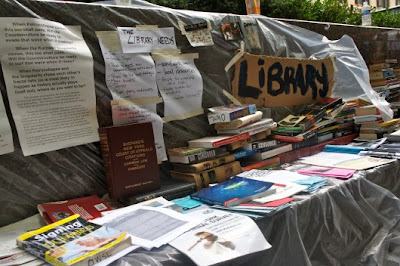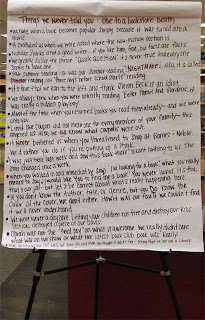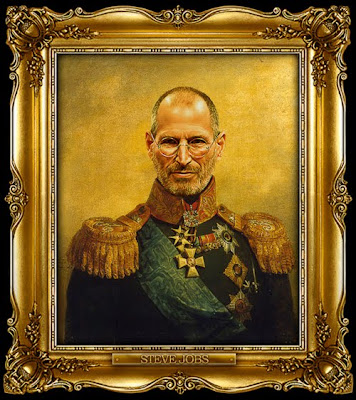(Via Libraryland.)
Tracking innovation, development and experimentation in information studies and library science and spotting new technologies, trends, fun stuff and much more.
Friday, September 30, 2011
The Van Gogh Letter Sketches
A nice collection at Bibliodyssey
And all 133 are available at vggallery.com
The Men of the Stacks (hunky calendar)
From the project:
We know what people think: Dewey, glasses, shushing, books, hairbuns, Party Girl and card catalogs. Yes, we know what people think. We know that the American, library profession is approximately 80% White and 72% female; and we know that tens of thousands of librarians are expected to reach age 65 in the next 5 years. We also know that this is not us.
There is an entire population of professional librarians out there who disagree with the way the library profession is perceived in contemporary media outlets and in the historical consciousness of the American mind. Different people and different associations will use different means to try to change those perceptions. This is ours.
The Men of the Stacks project was first conceived a couple of years ago after learning of the publication of another library-themed calendar. Our first reaction to that calendar? “Well, cool but…where are all the men?” There was another, earlier calendar that featured only male librarians, but we felt it didn’t quite capture the way we saw ourselves. In both cases, either the stereotype was reinforced or it didn’t go far enough in breaking free of it.
One of our models, Von, captured the spirit of this calendar beautifully:“We can’t just leave it to others to tell the people who we are; that’s why the stereotypes about librarians continue to flourish. We have to be the ones to go out there and tell people who we are. It’s not enough to complain about inaccurate images of librarians; we must be able to present alternative, positive images in movies, books and, yes, blogs.” — Filipino LibrarianWho are we? We are The Men of the Stacks.
Now, he adds, calendars should be added to the list. So, who are we? What do we want to tell you about who we are? What are these alternative images? Easy. We are, or course, professionals. We are educators, programmers, project managers, entrepreneurs, program coordinators, contractors, consultants, and speakers. We are academics. We are authors, diversity officers, historians, administrators, deans, professors, and researchers. We are creatives. We are musicians, bakers, painters, and storytellers. We are athletes, yogis, gym-rats, runners, and hikers. We are passionate. We are dog-lovers, radicals, conservatives, Christians, and Buddhists. We are in our twenties. We are in our forties. We are in relationships. We are perpetual bachelors. We are privileged beings who try to use their advantages to better the lives of others.
Thursday, September 29, 2011
1920s Transit Posters
During the 1920s, the Chicago Rapid Transit Company commissioned the city's finest graphic artists to produce advertising posters that encouraged Chicagoans to use rapid transit for more than commuting to work. The images produced beckoned Chicagoans to the city's parks, museums and other urban spots, as well as to more bucolic destinations beyond the city limits.
Many more beautiful examples.
We live in amazing times (video)
When Neil deGrasse Tyson met Carl Sagan
This is a seriously incredible story. If you did not already kind of love Carl Sagan, and think of him as a sort of benevolent hippie grandpa, you totally will now.
And the message here is seriously spot-on: The best way to honor the people who helped you realize your dreams is to help somebody else realize theirs.
From Boing Boing Via Joanne Manaster
The publication and sale of this book led to obscenity trials...
The publication and sale of this book led to obscenity trials in the U.S., Britain, Canada, Australia, Japan, and India.
(Via Libraryland.)
The 12 coolest libraries in the world
Yale University's Beinecke Rare Book and Manuscript Library, built in 1963, is the largest building in the world reserved exclusively for the preservation of rare books and manuscripts.
The 362,987-square-foot library, which can hold about 1.45 million books, has a unique, striking appearance consisting of several discrete 'floating platforms' seemingly wrapped in a large steel net around a glass skin.
The rest are at The Calgary Herald.
Protest Library
There are a lot of positive aspects to what's been going on in Lower Manhattan courtesy of the Occupy Wall Street movement but there is one part in particular that was unexpected. It is the makeshift library that has sprung up to provide protestors with some reading material.
Quite a few people have been camping out, some since it all began on September 17, so it is great to see that they have the ability to feed their mind while they participate in the occupation.
Titles include Orwell's Animal Farm, a biography of Emma Goldman, Nick Hornby's Housekeeping vs. Dirt, a collection of his bookish pieces from The Believer, and a copy of Democracy in America by De Tocqueville among many others.
(Via Book Patrol.)
The World in 2000 as Predicted in 1910
Wednesday, September 28, 2011
Angry note from former Borders employee
Borders locked up the last of its brick-and-mortar bookstores a few weeks ago. The above list of gripes — reportedly posted at one of many out-of-business outlets — claims to speak for all Borders employees. A bit bitter, I think.
A transcript follows, courtesy of EW’s Shelf Life:
- We hate when a book becomes popular simply because it was turned into a movie.
- It confused us when we were asked where the non-fiction section is.
- Nicholas Sparks is not a good writer … if you like him, fine, but facts are facts.
- We greatly dislike the phrase “Quick question.” It’s never true. And everyone seems to have one.
- Your summer reading list was our summer reading NIGHTMARE. Also, it’s called summer reading, not three days before school starts reading.
- It’s true that we lean to the left and think Glenn Beck is an idiot.
- We always knew when you were intently reading Better Homes and Gardens, it was really a hidden Playboy.
- Most of the time when you returned books you read them already — and we were onto you.
- Limit One Coupon did not mean one for every member of your family — this angered us. Also, we did know what coupons were out.
- It never bothered us when you threatened to shop at Barnes & Noble. We’d rather you do if you’re putting up a stink.
- “I was just here last week and saw this book there” meant nothing to us. The store changed once a week.
- When you walked in and immediately said, “I’m looking for a book,” what you really meant to say is, “I would like you to find me a book.” You never looked. It’s fine, it’s our job — but let’s be correct about what’s really happening here.
- If you don’t know the author, title, or genre, but you do know the color of the cover, we don’t either. How it was our fault that we couldn’t find it we’ll never understand.
- We were never a daycare. Letting your children run free and destroy our section destroyed a piece of our souls.
- Oprah was not the “final say” on what is awesome. We really didn’t care what was on her show or what her latest book club book was. Really.
- When you returned your SAT books, we knew you used them. We thought it wasn’t fair — seeing that we are not a library.
Marine Corps Guide to Social Media. Very surprising.
In a very thoughtful and well produced document the United States Marine Corps outlines its position on the use of social media by its members.
The Marine Corps encourages Marines to explore and engage in social media communities at a level they feel comfortable with. The best advice is to approach online communication in the same way we communicate in person — by using sound judgment and common sense, adhering to the Marine Corps’ core values of honor, courage and commitment, following established policy, and abiding by the Uniform Code of Military Justice (UCMJ).
The social media principles provided in this handbook are intended to outline how our core values should be demonstrated, to guide Marines through the use of social media whether personally involved or when acting on behalf of the Marine Corps.
View in its entirety (pdf) here.
Atlas of Florida's Natural Heritage. An amazing book.
The Florida Natural Areas Inventory is pleased to announce the publication of the Atlas of Florida’s Natural Heritage: Biodiversity, Landscapes, Stewardship, and Opportunities. This high-quality, full-color Atlas is sure to become a standard reference for anyone involved in the conservation, management, study, or enjoyment of Florida’s rich natural resources. We hope the Atlas will inspire, educate, and raise awareness of and interest in biodiversity and conservation issues.
Mike Plummer of WFSU’s Dimensions television program had several nice things to say about the Atlas “…loaded with graphic illustration and photography to explain the subject matter, this book is just plain fun to look through. It’s the kind of book you can pick up off the coffee table and spend 10 minutes with and you will have learned something new about the wonderful state of Florida.” Learn more about the project from a short and beautifully shot video by FNAI staff Gary, Carolyn and Jon by clicking this link.
Beautiful book art by Lisa Occhipinti
Lisa Occhipinti is a mixed media artist, designer and author.
She creates multi-layered paintings and distinct bookart objects, that at first appear simple, but upon closer observation are laden with visual information.
Transforming things rather than always creating anew, Lisa constructs artworks with found objects that lend their own histories. She is then challenged to merge these pieces with her own sensibilities while maintaining what attracted her to those things in the first place. The result is art pregnant with message, meaning and mystery. Though personal and enigmatic, her work speaks in a universal language luring the viewer with quiet familiarities and a sensual earth-toned palette.
More artbooks at the link.
Bookshelf made from books
So many books are thrown away each year, and although recyclable, the emotional bond that is attached to books seem to make them more appropriate for re-use than recycling. The idea for a shelf made from books seems almost obvious, and the process from concept to completion was more of a refinement of function than of aesthetic intricacies. The shelf gained widespread media attention and was published in several magazines.Via The Bookshelf
Gorgeous Grimm: 130 Years of Brothers Grimm Visual Legacy
What evil stepmothers and conniving wolves have to do with understanding the future of reading.
The fairy tales of the Brothers Grimm, part of UNESCO’s Memory of the World Register for the preservation of cultural documents, have been delighting and terrifying children since 1812, transfixing generations of parents, psychologists, and academics. The Fairy Tales of the Brothers Grimm is an astounding new volume from Taschen editor Noel Daniel bringing together the best illustrations from 130 years of The Brothers Grimm with 27 of the most beloved Grimm stories, including Cinderella, Snow White, The Little Red Riding Hood, and Sleeping Beauty, amidst artwork by some of the most celebrated illustrators from Germany, Britain, Sweden, Austria, the Czech Republic, Switzerland, and the United States working between the 1820s and 1950s.
The new translation is based on the final 1857 edition of the tales, and stunning silhouettes from original publications from the 1870s and 1920s grace the tome’s pages, alongside brand new silhouettes created bespoke for this remarkable new volume.
An introduction by Daniel explores the Grimms’ enduring legacy, from the DNA of fairy-tale scholarship to the shadow play and shape-shifting at the heart of the stories, and a preface to each tale frames it in its historical and sociocultural context.
The Grimms’ were a vital engine for a whole new caliber of artistic activity [...] Suddenly, artists across the Western world could make a living illustrating books, and they found a solid foundation for new work in the heroes and princesses, talking animals, dwarfs, and witches of fairy tales. The tales were an important part of each technological advancement along the way, and the best of this visual iconography still influences artist, art directors, filmmakers, and animators today [...] Even as our modes of reading continue to change with new technologies, taking a measure of the interactivity of text and image in past treasures helps us understand the changing landscape of reading in the future.”
And in case you were wondering why Taschen, purveyors of high-end and often risque art and design books, are doing a children’s book, they’ve got a thoughtful answer:
Taschen recently celebrated its 30th anniversary. We have many readers who have come of age with us and are now have their own families. These readers are interested in beautifully produced children’s books that take seriously a child’s exposure to stories and images with depth and historical meaning. We wanted The Fairy Tales of the Brothers Grimm to embody our mission to create meaningful books that are timeless yet original, modern but classic.”
Rigorously researched and breathtakingly art-directed, The Fairy Tales of the Brothers Grimm is a whimsical wonderland in its own right, blending seminal cultural history with our private individual nostalgia in an utterly gorgeous volume to charm the design lover, the history buff, and the eternal kid all at once.
Some images courtesy of Taschen
(Via Brain Pickings.)
Tuesday, September 27, 2011
The Future Of Books: A Dystopian Timeline
With the launch of the Kindle Fire tomorrow, John Biggs over at TechCrunch thought it would be fun to write a little bit sci-fi and imagine what the publishing market will look like in the next ten or so years.
Here are his predictions and more at the link.
2013 – EBook sales surpass all other book sales, even used books. EMagazines begin cutting into paper magazine sales.
2014 – Publishers begin “subsidized” e-reader trials. Newspapers, magazines, and book publishers will attempt to create hardware lockins for their wares. They will fail.
2015 – The death of the Mom and Pops. Smaller book stores will use the real estate to sell coffee and Wi-Fi. Collectable bookstores will still exist in the margins.
2016 – Lifestyle magazines as well as most popular Conde Nast titles will go tablet-only.
2018 – The last Barnes & Noble store converts to a cafe and digital access point.
2019 – B&N and Amazon’s publishing arms – including self-pub – will dwarf all other publishing.
2019 – The great culling of the publishers. Smaller houses may survive but not many of them. The giants like Random House and Penguin will calve their smaller houses into e-only ventures. The last of the “publisher subsidized” tablet devices will falter.
2020 – Nearly every middle school to college student will have an e-reader. Textbooks will slowly disappear.
2023 – Epaper will make ereaders as thin as a few sheets of paper.
2025 – The transition is complete even in most of the developing world. The book is, at best, an artifact and at worst a nuisance. Book collections won’t disappear – hold-outs will exist and a subset of readers will still print books – but generally all publishing will exist digitally.
(Via TechCrunch.)
The Enigma Machine Explained
As technology increases, so do the methods of encryption and decryption we have at our disposal. World War II saw wide use of various codes from substitution ciphers to employing Navajo code talkers in the Pacific theater. Here, science journalist and author Simon Singh demonstrates the German enigma machine, a typewriter-like device used to encrypt communications. He demonstrates not only its operation, but both the strength and fatal flaws in its method.
Via Coudal Partners
A private library in the trees
A short film about New York architect Andrew Berman's dream project.
Commissioned to design a writing studio in the woods in Long Island, he took the challenge and created a building which seems to float in a sea of foliage.
The film, while informative conveys the tranquility of the building by simply inviting you to enter and experience the pace of the writer's world inside.
Replaceaface
Top 10 misused English words
10. Refute
9. Instant
8. Enormity
7. Less
6. Chronic
5. Literally
4. Panacea
3. Disinterested
2. Decimate
and
1. Ultimate
Monday, September 26, 2011
Rubber bookshelves
Luke Hart created these rubber bookshelves for The Sculpture House. They have the delightful impracticality of all the everyday objects crafted from rubber that appear in old Warner Brothers cartoons, and the bright red coloring is an especially nice touch.
(via Bookshelf)
(Via Boing Boing.)
























